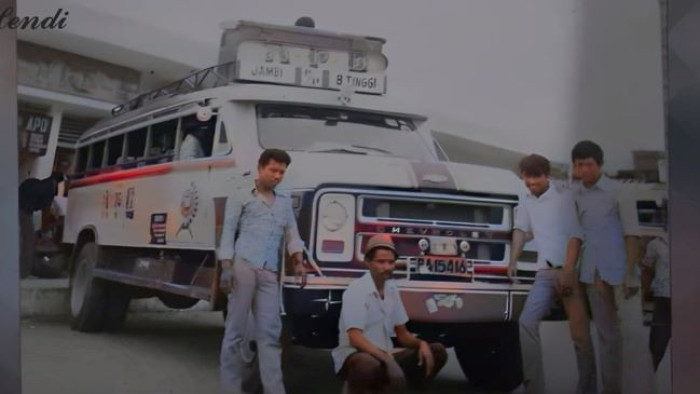
OTO
BY Yenny Narny (Dosen FIB Unand)
Hello Pakansier. How have you been? It's been a long time. This time, we follow the tracks of the buses that accompanied the Minangkabau people on their migration. As we know, the Minangkabau people are a tribe famous for their wandering tradition. This tradition is an integral part of the culture and identity of the Minangkabau people (Mochtar Naim, 2001). This is reflected in a saying that is very popular among the Minang people,
"Karantau madang dihulu, babuah babungo balun, marantau bujang first, di rumah paguno balun". This proverb describes social norms that value the role and responsibility of boys to migrate and leave their hometown. In the context of this proverb, "karantau madang dihulu" refers to the wandering journey undertaken by boys after marriage. "Babuah babungo balun" means that he has to go abroad to prove his ability to earn a living and build a career outside his hometown. Meanwhile, "marantau bujang first" indicates that before marriage, a boy is also expected to migrate to seek experience and economic capital before returning to his hometown to marry.
Overall, this proverb means that going abroad is considered a necessity and an inseparable part of the self-formation process for a Minangkabau man. By going abroad, he can prove his abilities, broaden his horizons, and gain helpful experience for personal and family progress. This also reflects respect for a person's independence and resilience in facing life's challenges outside their familiar environment (Franz and Keebet von Benda-Beckmann, 2007). For this reason, Minangkabau people take various routes to reach overseas countries, either by land, sea, or air.
Of all the routes taken, the land route usually leaves more memories in the hearts of the Minang people, especially the generation from the 70s to 80s. Many stories are recorded, from the romance of a beautiful journey, which sometimes ends in an arranged marriage, to enjoying various culinary delights at every stop and the busyness of passengers with their luggage. This generation also faces traffic jams and cars that sometimes suddenly break down or have to change tires. Feel the heat in a bus not equipped with AC technology, or enjoy the beautiful view of the Sunda Strait when you have to cross Bakauheni Harbor for those who want to go to Java Island.
In fact, car transportation is common in West Sumatra. The Dutch colonial government introduced this technology at the beginning of the 20th century, but its use was still limited. After the colonial government left, cars became the primary transportation choice for many people. The costs are affordable for the lower middle class (Mardanas Safwan et al., 1987). This provides business opportunities for several people. Auto Companies (PO) began to emerge. Some are PO Triarga and Cemerlang, which serve the Padang-Bukittinggi route. The Payakumbuh-Padang route is controlled by Bintang Kejora, Bunga Setangkai, and Sinamar. Gumarang, APD, APB and Minang Jaya control the Padang Batusangkar route. Corner 44 on the Lubuk Basung-Bukittinggi route is owned by PO Harmoni, and the route from Lubuk Basung to Padang is served by Dagang Pesisir. The Padang-Sawahlunto and Padang-Sijunjung routes, which have several names such as ADS, HZN, and Dasrat, were once very famous. The same thing was experienced by PO Terang and Ubani, which serve the Padang-Solok route. One route that has survived for a long time is Painan-Padang, served by Guntur Super, Habeco, Erlindo, and several other companies (Mardanas Safwan et al., 1987).
For Inter-City Buses Outside the Province, start with PO. NPM Bus. NPM itself has an acronym for Rise to the Mining Company. The official NPM website, busnpm.com, states that this company was founded on November 1, 1937, during the colonial era. It was founded by Bahauddin Sutan Barbangso Nan Kuniang, a bendi businessman. NPM serves the Padang, Java, and Jakarta routes. NPM has served the Padang Panjang – Sawahlunto, Padang Panjang – Bukittinggi, and Bukittinggi – Padang routes long before serving this route. PO Oto is almost the same age as NPM and is APD (Industrial and Trade Transport).
No written source has been found that states the exact date of the founding of this company. According to Haluan.com, PT APD was founded in the 1930s under the name NV. PPE. APD previously provided public bus services and delivered letters and goods from Padang Panjang to various cities on its route, which crossed Padang Panjang, Batusangkar, Sijunjung, Sungai Dareh, Muara Tebo, Muara Bungo, Bangko, Sorolangun and Lubuk Linggau. In the late 90s, PPE declined and disappeared from busy routes across Sumatra. If PPE doesn't hold up, it's a different story with PO. ANS was founded by H. Anas St. Jamaris in 1970. ANS is the one that has successfully served routes not only in Sumatra but also in Bali. Even though it has experienced ups and downs, this company still exists and now serves routes within and outside the province.
Following in the footsteps of these buses not only brings us memories of the past but also leads us to see again how these buses have become silent witnesses to the life journey of some Minangkabau people. This story about buses as a means of transportation and a spiritual journey births an unforgettable life story.
A proverb embedded in the Minangkabau people's soul reflects a life that is inseparable from searching for identity to proving one's abilities in the wider world. The buses that accompany the Minangkabau people in their migration are not just vehicles; they are historical painters who color the pages of ethnic life that are rich in values and traditions. ***





